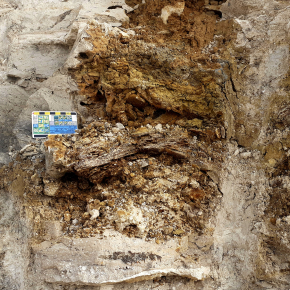Breakthrough in dating ancient karsts: the U-Pb method reveals the secrets of the Parisian underground
September 25, 2024
The formation of karsts, these underground networks shaped by the dissolution of soluble rocks, has long been a mystery as to its precise chronology. A team of researchers from the CNRS Earth & Universe (see box) and the BRGM has just unveiled this process using dating technology, offering new perspectives to understand the evolution of our landscapes and water resources.
Moreau, K., Brigaud, B., Andrieu, S., Briais, J., & Quesnel, F. Determining the age and origin of a Tertiary karstic system by in situ U-Pb geochronology on speleothems. Geology (2024)

For the first time, scientists have demonstrated the remarkable potential of uranium-lead (U-Pb) dating applied to fine calcite cements such as floating calcites(1) , to determine the age of karstifications going back several million years. This major advance has allowed to highlight the unsuspected precocity of the karstification of the continental rupelian limestone(2) of the Paris basin.
The research team applied this method to date the first calcite cements formed in a karstic system of oligocene continental limestone from the Etampes Limestone, in the Paris Basin. In total, 43 samples of floating calcites and other precipitated cements along the walls were analyzed in three karst cavities. The results obtained were unexpected: U-Pb ages are concentrated around 29 1 million years, coinciding with the period of formation of the encaissante rock itself (≈ 29 Ma).
This finding suggests that lithification(3), rock dissolution and speleothema precipitation(4) occurred in a remarkably short time span, not exceeding 2 million years after the initial deposition. Even more surprising, the presence of ostracodes(5) trapped between the levels of rupelian floating calcites indicates that karst developed in depth just before a phase of lacustrine sedimentation on the surface, revealing a potential syn-genetic character(6) .
The researchers attribute this very early dissolution to the uplift of the Paris Basin, a direct consequence of the alpine orogeny. This discovery opens new perspectives for the understanding of ancient geological processes. The U-Pb in situ dating technique on fine calcite cements is promising not only for indirectly dating karstification or fossils trapped in karsts, but also to study sedimentation and geological events in sedimentary basins, even in the absence of surface deposits.
This innovative study highlights the importance of developing new analytical methods to unlock the secrets of our subsoil. It offers crucial potential applications in a variety of fields, from water resource management to land use planning and the reconstruction of past landscapes and climates.
Involved laboratories
Géosciences Paris-Saclay (GEOPS – OSUPS)
Tutelles : CNRS / Université Paris-Saclay
Laboratoire Chrono-environnement (LCE)
Tutelles : CNRS / Université de Franche-Comté
Laboratoire de Géologie de Lyon : Terre, Planètes, Environnement (LGL TPE – OSUL)
Tutelles : CNRS / Université Claude Bernard Lyon 1 / ENS de Lyon / Univ. Jean-Monnet Saint-Étienne
Other
Bureau de Recherches Géologiques et Minières (BRGM)
Tutelles : Ministère de l’Enseignement supérieur, de la Recherche et de l’Innovation / Ministère de la Transition écologique
Contact
Notes
- Thin layers of calcite crystals that form on the surface of water in caves
- Lower Oligocene geological stage, approximately 33.9 to 28.1 million years old
- The process by which a sediment becomes consolidated rock.
- Mineral formations developing in caves, such as stalactites and stalagmites.
- Small crustaceans whose fossils are often used as paleoenvironmental indicators.
- A process occurring simultaneously or shortly after the formation of the enclosing rock.